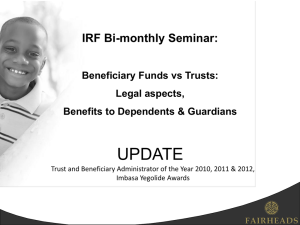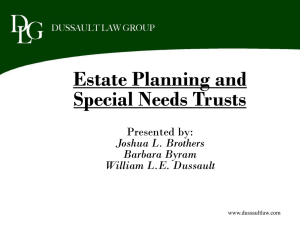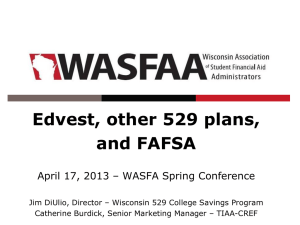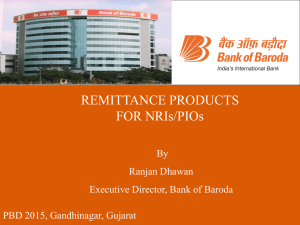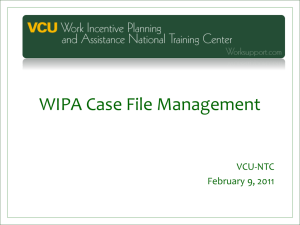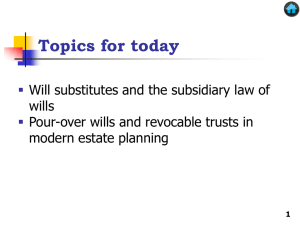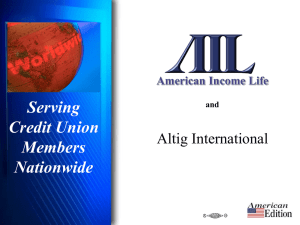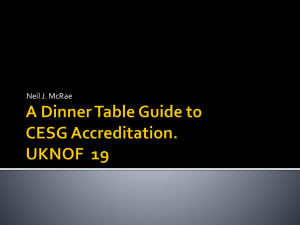Why Save for a Child`s Education?
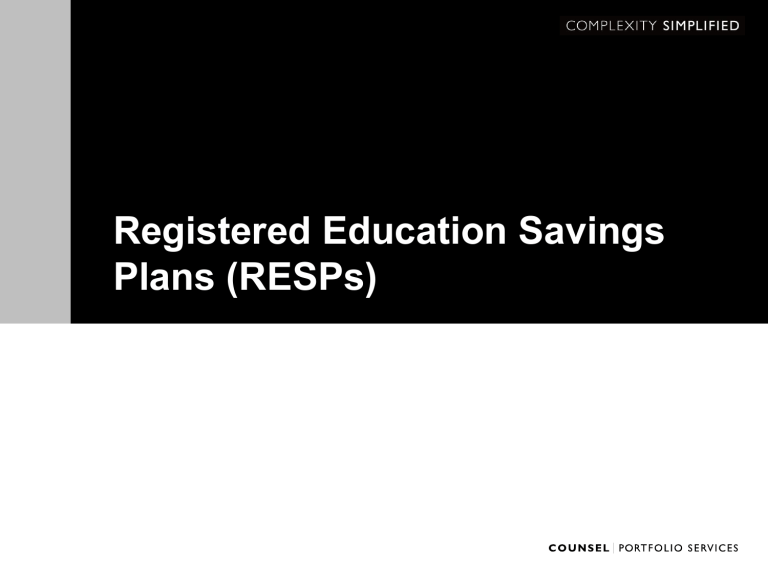
Registered Education Savings
Plans (RESPs)
Why Save for a Child’s Education?
University tuition
1988: $1,100
*
2013: $7,000
**
2023: $?
4 year program today:
• $40,000?
• $60,000?
• $80,000?
*Approximate. Source: Canadian Federation of Students.
** $6,882 University of Western Ontario tuition 2012-2013
Why Save for a Child’s Education?
• Post-secondary education costs are significant and have risen considerably over the past 10 years
• Planning ahead can make saving more affordable and allows you to take advantage of compound growth over time
– Help avoid significant debt-load so parents can focus on saving for their retirement
– Help avoid burden of student loans which can take years to pay off, in turn delaying achievement of the student’s life goals
• Assistance is available from the federal government to support education savings
What is an RESP?
A Registered Education Savings Plan (RESP) is an account used to save for post-secondary education
Basic Structure:
• The subscriber - Makes the contributions
• The promoter - Administers the RESP
• The beneficiary - Attends a post-secondary program
How Does an RESP Work?
Diagram is simplified and represents a situation where contributions qualify for receipt of any government grants and the beneficiary attends post-secondary education.
RESP Benefits
• Contributions to the plan grow over time on a taxdeferred basis
• Contributions may qualify for various government grants
• Eventual withdrawals of investment income and grants are usually taxed in the beneficiary’s hands at a lower rate
• Where the beneficiary has little or no income, they will pay no tax on these withdrawals
Basic Beneficiary Requirements
Must:
• Have a valid Social Insurance Number (SIN)
• Be a resident of Canada when designated as beneficiary
• For Family Plan only : be under age 21 when named a beneficiary
Your Contributions
• Contributions are non tax-deductible from a subscriber’s income
– Interest paid on money borrowed to contribute to an RESP cannot be deducted from income
– Only qualified investments can be purchased
• There are no annual contribution limits
• The lifetime limit is $50,000 per beneficiary
RESP Grants and Bonds
• There are two types of grants available:
– Canada Education Savings Grants (CESG)
– Provincial education savings grants
^
– Alberta Centennial Education Savings Plan Grant (ACESPG)
• There is one type of bond available:
– Canada Learning Bond (CLB)
^ The Quebec Education Savings Incentive is not offered in a Counsel RESP.
Canada Education Savings Grants
• An incentive provided by Human Resources & Skills
Development Canada (HRSDC)
• Equal to 20% of annual contributions made to all eligible
RESPs to a maximum of $500 for each beneficiary per year*
• Lifetime limit of $7,200 per beneficiary
• HRSDC will pay “Additional CESG” for each qualifying beneficiary based on the subscriber’s net family income
**
:
– Additional 20% on the first $500 contributed if household income is less than or equal to $41,544
• $600/year
– An extra 10% on the first $500 if household income is between
$41,544 and $83,008
• $550/year
* Where unused CESG room is ‘carried forward’, $1,000 per year may be earned.
** 2011 tax year.
CESG Rules and Eligibility
• Beneficiaries may qualify for CESGs up to the end of the calendar year they turn 17
• Beneficiaries who are 16 or 17 can receive CESGs if:
– A minimum of $2,000 in contributions have been made and not withdrawn before the year the beneficiary turns 16
Or,
– A minimum of $100/year has been contributed and not withdrawn in any of the 4 years before the beneficiary turns
16
– Beneficiary must be a resident of Canada when contributions were made
Canada Learning Bond
• An incentive provided by HRSDC
• For beneficiaries born after January 1, 2004
• Maximum benefit is $525 initially and $100/year until the beneficiary turns 15
• Family must receive the National Child Benefit
Supplement each year to qualify
Alberta Centennial Education Savings Grant
• For Alberta parents only
• $500 to the RESP of any child born in Alberta after
Jan 1. 2005, plus 3 annual contributions of $100 when the child turns 8, 11 and 14 provided that the child is attending school in Alberta*
• If the child does not attend a post-secondary educational institution, the grant money must be repaid
*or satisfies the Ministry of Advanced Education and Technology criteria.
Family Plans
• Beneficiary(ies) must be related (by blood or adoption) to subscriber
• New beneficiaries can be added any time (without limit)
• Money in the plan is ‘communal’
– Any beneficiary under the plan can use any part of the funds for educational purposes
• For non-siblings, they must be related to the subscriber
(not to each other)
Individual Plans
• Only one beneficiary
• Beneficiary cannot be changed
– but the account can be transferred to a new individual account
• No restriction on age of beneficiary,
– but if beneficiary is over 17, they will not be eligible for the CESG
Withdrawals from an RESP
Two reasons that RESPs can be withdrawn from:
1. For educational purposes
– Educational Assistance Payment (EAP) or
– Post Secondary Education (PSE) withdrawal
2. For non-educational purposes
– Accumulated Income Payments (AIPs)
Note: For either, subscriber contributions can be withdrawn at any time. This is called a capital withdrawal.
RESP Withdrawals for Educational Purposes
What is it?
Taxable
EAP (Educational
Assistance Payments)
Withdrawal from:
• the investment growth
• government grants
• To beneficiary
• Reported as income
PSE (Post Secondary
Education)
Withdrawal from the contribution amount
Tax free
Limit on withdrawal? Yes No limit
EAP Withdrawal Limits
Type of
Education
Program
Qualifying educational program
Specified educational program
Program Requirements
At least 3 consecutive weeks long, 10+ hours/week
At least 3 consecutive weeks long, 12+ hours/month
Withdrawal Limit
First 13 consecutive weeks - $5,000 max. (after this, no limit)
First 13 consecutive weeks - $2,500 max.
• No withholding taxes on EAP redemptions
• Beneficiary cannot be enrolled in an educational program as part of their employment
• Beneficiary must be a resident of Canada
Beneficiary Attends Post-secondary Education
To Beneficiary(ies) (for educational purposes only)
EAP
Growth on grants/bonds
Growth on your contributions
Grants/bonds
Your contributions
PSE
To Subscriber (for educational purposes only)
What Happens if the Beneficiary Does Not
Attend Post-secondary Education?
Capital Redemptions :
– Tax-free payment to subscriber from the contribution portion of the RESP
– This will trigger a claw-back of any grants earned
– CESGs can be used by a sibling (provided that the sibling has contribution room), otherwise all grant money must be repaid to HRSDC
What Happens if the Beneficiary Does Not
Attend Post-secondary Education?
Accumulated Income Payment (AIP):
• A withdrawal of earnings* by the subscriber that is not intended for educational expenses
– Subscriber can roll over the earnings to an RRSP provided there is contribution room. The maximum roll over allowed is $50,000.
– Or, taxed as income, plus an additional penalty tax of 20%. A T4A is issued to the subscriber
• Only allowed when the following conditions are met:
– The subscriber is a resident of Canada
– Payment(s) is made to individual subscriber(s) of the plan (no joint payments)
– The plan has been open for 10 years
– Each individual beneficiary is over 21 years of age, or
• the plan is being closed after 35 years, or
• all beneficiaries are deceased
* Earnings on grants/bonds & your contributions
Beneficiary Does not Attend Post-secondary
Education
To your or your spouse’s RRSP
AIP
To you or your spouse (non RRSP). Taxable, plus
20% penalty tax
Growth on grants/bonds
Growth on your contributions
Grants/bonds
To government
Your contributions
Back to you
Why a Counsel RESP?
• For clients with other Counsel accounts, consistency of investment approach
– Counsel investment philosophy and process extended to
RESP investments
• Detailed reporting through the Quarterly Portfolio
Review
• No account or trustee fee
Who is Counsel Portfolio Services?
A portfolio services company that:
• provides investors with disciplined approach to investing for the long-term
• provides solutions that are efficiently diversified and effectively managed – automatically rebalanced
• maintains a strict adherence to independence in money management
• through research & due diligence, take an objective approach to hiring external investment specialists
• ability to replace a specialist who fails to meet criteria for their respective investment mandates
Who is Counsel?
• Portfolio composition based on objectives;
• Selection and oversight of our investment specialists;
• Independent accountability and review;
• Administration:
Automated portfolio rebalancing
One consolidated report
Easy online portfolio access
Consolidated tax reporting
Disclaimers
Counsel Portfolio Services Inc. is a direct subsidiary of IPC Portfolio Services Inc., which is in turn an indirect subsidiary of Investment Planning Counsel Inc. IPC Investment Corporation, a registered mutual fund dealer and IPC Securities Corporation, a registered investment dealer, are wholly-owned subsidiaries of IPCC. Copyright - Counsel Portfolio Services Inc.
Commissions, trailing commissions, management fees and expenses all may be associated with mutual funds. Please read the Simplified Prospectus before investing. Mutual funds are not guaranteed, their values change frequently and past performance may not be repeated. Investors should consult their investment professionals and tax advisors prior to implementing any changes to their investment strategies.
Last updated: 10/15/2012


